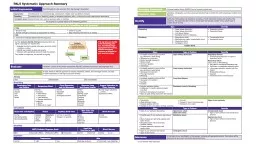

110 yr Systolic less than Age x2 70 gt 10 yr Systolic less than 90 Fluid Bolus Isotonic Lungs Clear 20mlkg Lungs Wet 5mlkg 20mlkg over 5 minutes 5mlkg over 20 minutes Vasopressor Support ID: 909357
Download Presentation The PPT/PDF document "Hypotensive Shock <1 yr. Systolic les..." is the property of its rightful owner. Permission is granted to download and print the materials on this web site for personal, non-commercial use only, and to display it on your personal computer provided you do not modify the materials and that you retain all copyright notices contained in the materials. By downloading content from our website, you accept the terms of this agreement.
Slide1
Slide2Slide3Hypotensive Shock
<1 yr. Systolic less than 70
1-10 yr. Systolic less than (Age x2) +70
> 10 yr. Systolic less than 90
Fluid Bolus (Isotonic)
Lungs Clear = 20ml/kg
Lungs “Wet” = 5ml/kg
20ml/kg over 5 minutes5ml/kg over 20 minutes
Vasopressor Support
(infusion)
Warm Shock = Norepi
Cold Shock = Epi
Slide4VF/pVT =
Defib
Start CPR
Defib 2 J/kg
2 minutes of CPR
Defib 4 J/kg
2 minutes of CPR &
Epi 0.01mg/kgDefib 4-10 J/kg2 minutes of CPR &Amio 5mg/kg orLido 1mg/kg
Asystole/
P
ulseless
Electrical ActivityStart CPR, Epi 0.01mg/kg ASAP (then every other rhythm check), H + T’sand recheck pulse & rhythm every 2 minutes. PEA = Push Epi Ask whyPEA = Push Epi All the timePEA = Push Epi AlwaysPEA = Push Epi Again
Post Cardiac Arrest Care
4 H’s to Avoid
Hypoxia: Maintain 94-99% SPO
2
Hypotension: Manage BP for age, use fluids or pressor
Hypoglycemia: Treat with D10 or D25
Hyperthermia: Don’t confuse with Targeted Temp Management
Also. prone to seizures, may monitor with EEG
Slide5# 1 Cause of Bradycardia in Pediatrics =
Hypoxia
1. Positive Pressure Ventilation First
2. If Heart Rate and patient condition does not improve, start CPR
3. Once vascular access obtained 0.01mg/kg Epi
4. Recheck pulse and rhythm every 2 minutes
*Consider Atropine if a heart block or increased vagal tone such
as suctioning, rectal temperature, or patient bearing down caused
the bradycardia
Slide6Identify patient as stable or unstable/poor perfusion (altered LOC or hypotension)
Stable = Medicine
Unstable (Poor Perfusion) = Edison
SVT or Monomorphic VT
Stable
= Vagal Maneuvers while preparing
Adenosine on a 3-way stop-cock and placing
defib pads on patient as a precaution
1
st
dose = 0.1mg/kg
2nd dose = 0.2mg/kgIf you are 100% sure it is Ventricular Tach, skip adenosine and proceed to amio/lidoSVT or Mono or Polymorphic VTUnstable = Cardioversion 0.5 to 1 J/kgIncrease to 2 J/kg if 1st shock not effective*Consider sedation, but don’t delay cardioversion